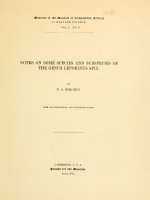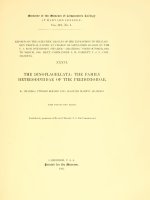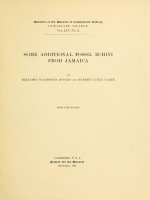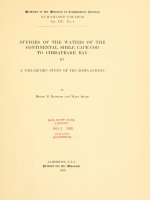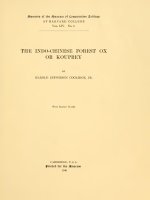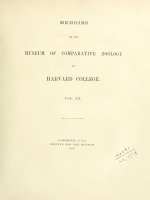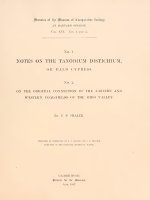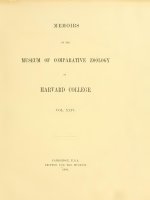Memoirs MCZ 5403
Bạn đang xem bản rút gọn của tài liệu. Xem và tải ngay bản đầy đủ của tài liệu tại đây (2.7 MB, 51 trang )
/niemoirs of
tlje
/iDuseum of Comparative Zoology
AT HARVARD COLLEGE
Vol. LIV. No.
3.
THE
PLACENTATION OF THE MANATEE
(Trichechus latirostris)
BY
GEORGE
B.
WISLOCKI
WITH SEVEN PLATES
CAMBRIDGE,
U.S.A.
IPrtnteD for tbe /iDuseum
December, 1935
THE PLACENTATION OF THE MANATEE
INTRODUCTORY REMARKS
Less
is
known about
mammals. Only two
the placentation of the Sirenia than of any group of
papers,
now some
fifty
years old, exist to the writer's know-
These, by Harting (1878) and Turner (1889),
ledge, regarding this subject.
describe the nature of the fetal inembranes in
mens
of Halicore dugong.
Consequently
receive a well-preserved, intact uterus
chus latirosiris)
of this
Study
.
it
and
two rather poorly preserved
was
of considerable interest to
fetus of the Florida
speci-
me
to
manatee {Triche-
specimen revises and extends to a large degree
the previous knowledge of placentation in the order Sirenia.
of the salient features of the placentation of the
A
summary
brief
manatee, as observed in this speci-
men, has been recently published (Wislocki, 1933). I wish to express
gratitude to Mr. George Nelson of the Museum of Comparative Zoology
i
my
of
deep
Harv-
ard University for securing this valuable and well-preserved pregnant uterus.
GROSS DESCRIPTION
The specimen
preserved fetus in
an entire gravid uterus containing an excellently
The length of the fetus is 44 cm. from snout to tip of tail.
consists of
situ.
a male, possesses the well-developed outer form of a manatee.
The
fetus,
The
skin at this stage
which
is
character of the fetus
The
uterus
is
is
is
set
with scattered short hairs or
well depicted in figure
bristles.
The
outer
1.
a bilobed object consisting of two short, stout cornua, one of
much
The
ovaries
had been
which, containing the fetus,
is
moved from the specimen;
the Fallopian tubes and cervix are present.
very
relationships of the uterus to the fetus
diagrammatically in figure
1.
The
enlarged.
and the
fetus
and
fetal
its
re-
The
adnexa are shown semi-
membranes including the
placenta are located entirely in the right horn of the uterus, no opportunity being
in the lowermost uterine
given, by virtue of the narrowness of the uterine lumen
for
segment, as well as by the fact that the two cornua join almost at the cervix,
the fetal
membranes
The most
to extend into the opposite horn.
striking thing
upon opening the uterus
is
the appearance of the
placenta. It surrounds the fetus as a thick, sharply dehmited purple belt or gir'
In this note I designated my specimen of the Florida manatee as Manatus latirosiris, basing my terI have
minology upon the classification given in the second edition of Max Weber's well-known book.
now changed the designation to Trichechus latirosiris, following the advice of Dr. Glover M. Allen.
PLACENTATION OF THE MANATEE
160
no sense be construed as being
die of the typical zonary type. Its appearance can in
topography and relationships are presented in figures 1, 2, 3 and 5.
The umbiUcal cord is a relatively short, stout mass which radiates Uke a
diffuse. Its gross
collapsed tent from the umbilical ring towards the placenta.
which there are two
sels, of
and one vein
arteries
The
umbilical ves-
at the umbiUcus, divide, within
a centimeter or two from the ring, into four sets of paired vessels which proceed
as four pedicles towards the placenta
The nature
divisions.
umbihcal cord
of these leashes of diverging vessels
shown
is
ceeds, unlike the others,
vessel, a small artery, is given off singly
and pro-
amnion
to reach
around the whole circumference
the placenta at a place remote from the umbiUcal cord
is
chorionic pole
smaller pole
is
is
more extensive than the other
oriented towards the uterine outlet.
completely membranous. The placenta
made up
is
(figs. 1
and
2).
placed to one side of the equator of the entire blastocyst, so that one
membranous
and
of the
placenta constitutes a broad girdle or zone of sharply defined tissue
The
which
which constitute the
In addition to the four major sets of paired
in figure 2.
one seemingly aberrant
vessels,
upon reaching which they undergo further
is
and 2). The
(figs. 1
Both chorionic
poles are
grossly of the type described as zonary
of a series of rather intimately
cemented lobes
of variable size
and contour ranging from four to eight centimeters in diameters (figs. 2 and 3).
The tendency to form lobes is best discerned along the periphery of the placenta.
On
cross section the placenta
is
found to consist
about one centimeter in thickness
(fig. 5).
of a rather firm plate of tissue,
The outer
red or purple, whereas the basal half, constituting
endometrium, is whitish, containing the cut aspects
ies
and
and a
The border
veins.
slightly
its
of
half of the placenta
(fig. 5).
deep
zone of junction with the
numerous endometrial
of the placenta is elevated, possessing
undercut edge
is
From this border the
arter-
a smooth contour
chorion leaves the pla-
centa as a stout, whitish membrane. In the placental zone the fetal tissues cannot
be stripped
intimate.
off
from the maternal, because the interlocking
is
two
is
much
too
Outside the area of the zonary placenta the chorion separates easily
from the uterus,
brane.
of the
The
its
outer surface presenting the appearance of a smooth
uterine surface which
is
mem-
uncovered by stripping away the chorion,
almost identically smooth. There are, however, scattered near the placental
border some half dozen small, round areas no larger than a half of a centimeter
in width where the chorion cUngs tenaciously to the endometrium.
discoidal patches are reddish.
On
These minute
microscopic section they prove to be, as their
gross appearance suggests, minute areas of chorionic attachment structurally
resembling the placenta.
They
are true accessory placental areolae, but their
GROSS DESCRIPTION
total area
is
be practically
3 and
and accordingly
quite negligible,
nil.
The
gross appearance
must
their functional significance
of these areolae
is
shown
in figures 2,
6.
The
membranous chorion
fetal surface of the
abundant blood-vessels, readily
the placental vessels
The
(fig. 2)
and
is
fused throughout
its
entire
suppUed by
naked eye, which are derived from
is
.
semidiagrammatically in figures
extensive,
visible to the
amnion and
relationships of
is
This chorio-allantoic membrane
extent with the allantois.
and
1
allantois are complex.
2.
The
allantois
is
They
shown
are
a lobulated sac which
is
fused everywhere with the chorion from pole to pole, excepting
and
where the amnion succeeds in appl>dng
to the chorion. Thus the allantoic sac is much more extensive than the
for a small triangular area
itself
161
(figs. 1
amniotic sac, and surrounds
it
2)
with the exception of the small triangular area of
amnio-chorionic fusion.
The
allantois consists essentially of four saccular diverticula,
median and two
larger lateral ones.
umbilical pedicle.
The
latter, as
two small
These sacculations are related to the curious
has been said above, consists of four stout
diverging pairs of blood-vessels which can be Ukened approximately to the four
The space within the pyramid is a
antrum from which commodious sacculations lead off through
edges of a hollow quadrilateral pyramid.
common
allantoic
the four sides of the pyramid between the marginal leashes of blood-vessels.
attempt tg show these complicated relationships has been made in figure
membranous
allantois,
form mesenteries
walls of the bulging sacculations
which ensheath the respective leashes
chorionic sac, lying side
surface.
It
is
by
lesser sacculations
side,
area of amnio-chorionic fusion
is
2) .
(fig.
triangular with
its
this point a curious, shallow vortex is
placenta into which the amnion apparently dips
The
It will be
The
vessels at the
noted that this
base near the umbilicus and
lesser allantoic saccu-
formed on the surface
(figs. 1
blood-vessels supplying the placenta and fetal
description.
of the placental
two sacculations that the triangular
where the amnion achieves a restricted
apex on the placenta contiguous to the apices of the two
At
of the
distal to the apices of these
fusion with the chorion overlying the placenta
lations.
and completely
occupy the equator
and fused with the chorion
area not occupied by the allantois exists
its
of reduplicated
and give them a
The two major saccu-
lations extend into the poles of the chorion, fusing with the latter
The two
The
of blood-vessels
mesentery-like attachment along their outer borders.
enclosing the amnion.
2.
An
and
of the
2) .
membranes merit a
umbihcal ring are three in number: two
brief
arteries
PLACENTATION OF THE MANATEE
162
and one
vein.
About two centimeters from the umbilical
ring these di\ade giving
four sets of divergent paired vessels which proceed to the surface of the
rise to
placenta.
In addition to these a pecuUar artery of
medium
size,
without ac-
companying vein, branches off from one of the umbilical arteries and courses
between the amnion and allantois to a distant point on the opposite side of the
placenta
given
Moreover, a number
2).
of
minute blood-vessels are
from the above enumerated paired vessels, which
the amniotic and allantoic sacs with a few fine branches. Thus
off at irregular intervals
supply the walls of
the
and
1
{art., figs.
membranous
walls of these sacs are not totally devoid of blood supply.
approaching the surface
of the placenta the four
the umbilical pedicle give off
surface
major pairs of vessels constituting
large branches which pass to the adjacent placental
The main stems
(fig. 3).
Upon
of the original vessels,
however, upon reaching
the surface of the placenta, course for long distances diminishing ultimately in
size
by giving
off
numerous subsidiary
These subsidiary branches, while
vessels.
traversing the surfaces of the placental lobes, give off a multitude of finer branches
(the ultimate ones visible to the
naked eye) which run from the centrally placed
vessels to the periphery of the lobes, lending to the surface of the latter a finely
streaked appearance
(fig. 3).
At the periphery of the zonary placenta numerous medium-sized and small
arteries and veins enter the membranous chorion supplying it to its utmost poles
with an abundance of small vessels
tois is
is
amply
much
vascularized.
The
(fig. 2).
Thus the membranous
vascularity of the
membranous
chorio-allan-
chorio-allantois
membranous redupUcavessels. The latter are rela-
greater than that of the amnio-allantois or of the
tions of allantois covering the leashes of umbilical
umbiUcal cord, but become
tively vascular in the neighborhood of the
one leaves the vicinity of the large
tered, as one retreats
from the
vessels.
\'icinity of
Areas
of
less
so as
amnio-chorion are encoun-
the cord, in which the slender vessels
supplying them appear to have become occluded. This observation suggests that
the walls of the amniotic and allantoic sacs are destined at later stages to lose
much
of their present blood suppl3^
Nothing has been said yet
The
cental vessels.
of the curious
morphology
of the walls of the pla-
four pairs of vessels constituting the umbiUcal pedicle reach
the placental surface, whereupon they give off branches which extend to
of the placenta.
of
them
parts
These vessels are not buried in the placenta but are raised for the
most part from the
Some
all
embossed upon it.
possessing small mesenteries. The most
surface, giving the appearance of being
are free to the extent of
characteristic thing regarding these vessels
is
the nature of their adventitial
GROSS DESCRIPTION
These are thickened
sheaths.
163
in a multitude of places to
protuberances projecting into the allantoic cavity
produce a variety of
3 and 4). These bodies
(figs. 2,
are white with a
waxy lustre. They occur about equally along arteries and veins,
uneven in number and distribution in different parts of the placenta.
but are
Moreover, a small percentage
of
them protrude from the
placental surface with-
out any distinct relationship to recognizable placental vessels. These bodies are
of three general types
mon
is
with
all
transitions
between them
(fig. 4)
.
The most com-
undoubtedly a protuberance on the vessel wall, seemingly Uke a drop of
wax. In a few instances these drops follow one another so closely as to give a
beaded appearance. Again for short distances vessels may appear as though
they had been coated with wax. Next in order of frequency come protuberances
that have surfaces which, instead of being smooth, are cauhflower-like. Finally,
in frequency
rectly
or in
come
similar cauliflower-Uke masses which, instead of resting di-
upon the placenta,* are attached to the placental surface by short stalks
some instances by long threads. The cauUflower-Uke terminal expansions
of these
pendulous structures are often flattened. None of the structures enumer-
ated are large, their greatest size being two to four milUmeters in diameter,
although the threads by which the longest pedunculated ones are attached
attain in
some instances a length
of
one to three centimeters.
appendages are irregularly distributed over the entire surface
including that small triangular area to which
amnion instead
may
These various
of the placenta,
of allantois is at-
They accompany the blood-vessels which leave the placental border to
vascularize the membranous chorion for only one to three centimeters at most.
tached.
Thus the inner
of
surface of the
membranous
chorio-allantois
is
practically devoid
them. Moreover, there are but occasional ones on the remaining membranous
walls of the allantoic sacculations. Similarly there are none visible to the
naked
eye on the umbiUcal cord. The amnion, excepting for a few excrescences Umited
to that small area of the
amnion which
is
fused with the placenta,
is
otherwise
devoid of these structures. The amnion possesses, nevertheless, a curious texture.
Running
one's finger over the wall of the amniotic sac gives the sensation of
cloth on which fine grains of sand have been sprinkled
it
can readily be seen that, instead
with the smallest
visible,
of
and on
being smooth, the surface
is
close inspection
closely
studded
whitish particles constituting minute elevations from
the surface. In contrast to the amnion the interior surface of the allantoic cavity
is
smooth, Uke the surface of
chorion and placenta
is
glass,
affected
excepting where
its
texture in the region of the
by the above described appendages,
PL AGENT ATION OF THE MANATEE
164
MICROSCOPIC DESCRIPTION
The most
interesting part of the microscopic examination of this specimen
concerns the nature of the zonary placenta. Both of the pre\aous investigators
(Harting and Turner) examined the placental area of their alcohoUc specimens
resorting mostly to studying small teased bits or
by rather primitive means,
Their pictures of these preparations show the inadequacy
free-hand sections.
of the technique.
However, from
their observations they
clusion that placentation in Halicore dugong
of simple interdigitation of intact fetal
is
diffuse
and maternal
both came to the con-
and adeciduate consisting
This finding
vilU.
The
trary to the present observations of the Florida manatee.
is
con-
sections of the
present specimen, which are fixed and stained by
modern technique, show beyond
a doubt that the zonary placenta of the manatee
is
That
one of deciduate character.
related
dugong
is
a highly complex labyrinthine
this observation holds also for the closely
extremely probable in view of the fact that grossly in numerous
major particulars, in so
Harting and Turner go, the morph-
far as the accounts of
ology of the placenta and fetal membranes in our several specimens
tallies
completely.
Following these anticipatory remarks,
I shall pass to a detailed description
The zonary
of the microscopic structure of the placenta in the present specimen.
placenta
is
band varying from one
a lobulated, thick
meters in thickness
(fig.
5)
.
It is
composed
of
to one
and a
half centi-
an irregularly thickened, relatively
pale-staining layer of tissue on the fetal surface of the placenta in which the fetal
Beneath
vessels are distributed.
five
milUmeters thick constituting the placental labyrinth in which the fetal and
maternal circulations become intimately united
deeply. Beneath this
of
lamina some four to
this outer covering is a
is
placental labyrinth
pletely deciduate in that
maternal and
upon microscopic examination proves
(figs.
cells.
12, 13, 14 and 15).
The endotheUum
accompanying the sUghtly larger
mesenchyma. The
com-
composed of a fine-meshed trelHs-work of fused
which separation of the two is impossible and in
are recognizable because the blood within
red blood
to be
it is
fetal tissues in
endometrium
This zone stains very
rests.
which there has been a loss on the maternal part
of the
7).
a Ught-staining zone of about equal thickness composed
maternal tissue upon which the labyrinth
The
(fig.
of
The
most of the
cellular
them contains here and
lining the capillaries
vessels there
components
fetal capillaries in the labyrinth
is
an
fetal capillaries are oriented for the
is
there nucleated
distinguishable,
and
additioiaal sheath of fetal
most part
in
rows from the
MICROSCOPIC DESCRIPTION
165
surface to the base of the placenta, but there are besides
numerous anastomoses
between them so that they are to a considerable degree plexiform. The maternal
blood spaces are narrow, tortuous channels, for the most part not injected with
blood, lying in the meshes between the fetal plexus.
is
In places, however, blood
recognizable within them, distinguishable from that in the fetal capillaries
the relative abundance of leucocytes in
and the absence
it
by
of nucleated erj^thro-
cytes.
Separating the maternal from the fetal vessels are narrow laminae of
an interpretation
of the nature of
placental labyrinth which
same character and
visible.
They have
and constitute
in
we have
is
important in determining the type
before us. These cells appear to be
to be syncytial in that boundaries
large, oval nuclei
pale-staining cytoplasm.
fetal capillaries.
which
They
cells,
all
of
of the
between them are not
surrounded by a relatively abundant, rather
These syncytial sheets
of cells invest the walls of the
enclose on their opposite faces the maternal capillaries
my estimation the Umiting walls of the maternal blood channels.
If this interpretation
be correct, the syncytiimi in question
is
trophoblastic and
of fetal origin. It constitutes, moreover, the sole enclosure for the
the latter circulating in labyrinthine spaces lined
then, the maternal blood-vessels must have
by
maternal blood,
trophoblast.
Evidently,
lost all of their tunics including the
endothelium, making of the labyrinth a hemochorial one according to the concept
of Grosser.
This decision has not been simple to make, because of the complexity
of the tenuous layer of cells
between the two
circulations.
The
that the syncytium intervening between the two circulations
and that some
possibihty remains
may not
be uniform
of the
homogeneous cells making up
the lamina may be swollen and altered maternal endotheUum. However, after
much study of the sections I believe that the interpretation that there is a hemo-
in character or derivation,
chorial type of labyrinth before us appears to be justified.
mitted would be that
of other
it is
in whole or part
The
an endotheUochorial labyrinth. Study
specimens of the placenta when further stages are obtainable
more complete answer to
this question.
the endometrium having been invaded
tion of the maternal epitheUum
may
give a
There remains, however, absolutely no
doubt whatsoever about the essential fact that the labyrinth
is
truly deciduate,
by trophoblast with the complete destruc-
and connective
tissue with the ultimate intimate
fusion of the trophoblast with eroded maternal blood channels.
are,
alternative per-
These findings
moreover, fully substantiated by studying the peculiar morphology of the
surface as well as the base of the placenta.
At the base
of the placenta tongue-like
masses
of fetal tissue,
resembUng
PLACENTATION OF THE MANATEE
166
chorionic
latter is
villi,
can be seen penetrating the mucosa
(figs. 15, 17,
The
18 and 21).
undergoing wide-spread erosion in the neighborhood of the advancing
trophoblast. These processes of fetal tissue are covered externally
trophoblast of the placental labyrinth which
is
by trophoblast;
mesoderm. Unlike the
in their interior they contain cores of vascularized fetal
syncytial and pale staining, the
trophoblast covering the growing tips of the villous processes, which are invading
composed of cells which are small, with deeply staining nuclei,
and which are for the most part rather regularly set. Indeed in many places the
the mucosa,
cells
is
appear to constitute cytotrophoblast instead of being syncytial. Between
the tongues of the chorionic
villi
are narrow bands of pale, rather acellular,
degenerating maternal connective tissue.
At
where large maternal
intervals
blood vessels reach the neighborhood of the placenta, the chorionic
have
villi
penetrated more actively into the mucosa, sending out long sprouts which
exhibit a tendency to follow the walls of the blood-vessels
(figs. 17,
A
18 and 21).
of the chorionic process
completely.
The darkly
curious observation
is
that the trophoblast on the side
apphed to the maternal
staining trophoblast
and to ensheath them
vessel changes its character
composed
which
of small cells,
characteristic of these basal prolongations of the chorion, changes
where
it
is
comes
in contact with the wall of the maternal vessel into syncytial trophoblast
the trophoblastic
cells
cytoplasm and nuclei
whereby
in
reactions
of both
become
immediately
paler
staining
(figs. 17, 19 and 21). This enclosing of the maternal ves-
accompanied by degeneration of the two outermost vascular tunics, advenand media, so that the maternal blood comes to flow in a confining channel
sels is
titia
of trophoblast.
To what
remain intact within
some
(fig.
vessels the
17),
this sheath is difficult to
endotheUum can be seen
but in other
19 and 21).
(figs.
extent the endotheUal elements of the maternal vessel
say with absolute certainty. In
definitely as a thin, nuclear
vessels, in places along their walls,
The endothelium being exceedingly
the fact that the specimen, although well fixed,
may
fixed for the complete preservation of so delicate a
sume that
it
was completely present during Ufe
it is
membrane
not discernible
deUcate, coupled with
not have been perfectly
membrane,
leads
me
in these larger afferent
to pre-
and
effer-
ent maternal trunks.
The
Some
uterine glands play no conspicuous role in the formation of the placenta.
distance below the basal layer of the labyrinth, in a less compact zone of
the mucosa, there are groups of glands scattered at irregular intervals
(fig.
16).
These glands are conspicuous neither by virtue of size nor by evidence of being
markedly secreting. They are small, with walls composed of a single layer of
MICROSCOPIC DESCRIPTION
low
which are not unusually
cells
active.
167
Their ducts pass outward toward the
base of the placenta where they are evidently sealed
Rarely, one of the
off.
glands in close proximity to the placental base appears to be somewhat dilated,
and
in
one section
into the
lumen
I
have come across a place where the trophoblast has erupted
such a dilated gland
of
(fig.
20).
Passing from a description of the basal portion of the placenta,
sary to turn our attention to the fetal surface of the organ
Here some
rather extraordinary features are present.
nal vessels, endotheUal-hned but otherwise ensheathed
The
(figs. 12,
by a tunic
which run
parallel to the surface
wall adjacent to the labyrinth,
(fig.
23).
(fig.
many
of their
numerous openings leading into the ultimate
from larger afferent
sinusoids that the maternal
In
22).
These possess, in that side
intervillous or intertrabecular spaces of the fine-meshed labyrinth.
transition points
,
of trophoblast,
zone of the labyrinth the vessels divide into short branches
this external
moment on
22 and 23)
larger afferent mater-
penetrate the placenta to reach the fetal surface of the labyrinth
of
neces-
it is
It is at these
vessels to the labyrinthine capillaries or
endotheUum
is lost,
the maternal blood from this
The
circulating in the interstices of the labyrinthine trophoblast.
opposite sides of the vessels bear a curious relationship to the trophoblast at the
surface of the placenta.
Between these
at the surface of the labyrinth
nant maternal blood which
cells (figs.
12 and 22).
is
is
vessels
and the limiting trophoblast
a series of recesses or lacunae containing stag-
being actively phagocytized by trophoblastic
These recesses containing extravasated maternal blood
constitute a narrow zone covering the entire placenta.
this region for histiotrophic
Thus provision is made
nourishment of the fetus by the destruction and
milation of stagnated maternal blood. This formation
hematomata (green and brown borders
of carnivores)
is
tures which I
and other
fig.
1)
giving
besides a
and
my
number
attempting to describe,
I
devices, mostly
mammalian
my readers may understand more fully the
am
assi-
the equivalent of the
paraplacental structures, for the histiotrophic nourishment of
In order that
in
fetuses.
nature of the struc-
have constructed a diagram
(text-
interpretation of the morphology of the zone under discussion,
of
photographs of the actual histological sections
(figs. 12,
22
23).
It
is
evident beyond doubt from the sections that there
is
a series of small
controphoblastic lacunae over the whole surface of the placenta. These pockets
tain stagnated maternal blood.
The
trophoblastic cells Uning the pockets are
unlike the trophoblastic cells seen in the form of syncytium in the bulk of the placental labyrinth or as small-celled cytotropho-blast described at the growing base
PLACENTATION OF THE MANATEE
168
of the placenta.
broad columnar
The
cells
trophoblastic cells in these recesses are separate, discreet,
with somewhat basally situated nuclei and a large amount
of distally placed vacuolated cytoplasm.
of
In the cytoplasm are large numbers
whole or fragmented erythrocytes, as well as a quantity
of
golden pigment,
the latter usually in the neighborhood of the nucleus.
FetV.
/TA/es.
Hist.
Tr.
-F^f. V.
Endo
Plac-
Lab.
Text-fig. 1. Diagram illustrating the author's interpretation of the structure and nature of the surface
of the placental labyrinth in the manatee. F. mes., Fetal mesoderm clothing the surface of the placenta
and accompanying the fetal vessels entering the labyrinth. Fet. v., Fetal vessels entering the labyrinth.
M.
Maternal vessel lined by endothelium (Endo.) communicating above with trophoblastic lacunae
which contain stagnant maternal blood (Hisl.) undergoing absorption by the trophoblast; and
below by a series of openings into the maternal blood channels of the placental labyrinth {Plac. lab.).
Note that neither the lacunae on the one side of the maternal vessel nor the channels leading into the
labyrinth on the opposite side are lined by endothelium.
v.,
(Tr. lac.)
The
question arises as to
Their source
lined
is
how
to be sought in the subjacent afferent maternal vessels
by endothelium ensheathed
apparently give
endothehum
these extravasations of maternal blood occur.
way
in trophoblast.
The endotheUal
which are
walls of these
in places, allowing maternal blood to escape through the
into adjacent pockets of trophoblast in which no free circulation
is
possible, so that stagnation follows.
One could conceive that such an extravasation, once having escaped
of the maternal vessel
might by
its
the limits
mere pressure lead to the formation
pocket-like indentation of the surrounding trophoblast.
reasoning to explain matters. However,
I offer
This
may
be
of a
sufficient
a further suggestion from a clue
MICROSCOPIC DESCRIPTION
169
given by examination of the extreme border of the placenta.
Here, as one ap-
proaches the edge of the placenta, the blood-containing lacunae dwindle in
size
and amount
of contained blood
(fig.
on the ultimate placental margin by
vacuolated, degenerating centers.
mass
in all likeUhood to be a
23).
The pockets
are finally replaced
clusters of syncytial trophoblast with
Thus the precursor
of the
redundant trophoblastic syncytium which has
of
accumulated between the maternal vessels and the overlying
The
the chorio-allantois.
lacunae appears
stroma
fetal
of
cores of these trophoblastic accumulations undergo
vacuolar degeneration, whereby the wall of an adjacent maternal vessel becomes
weakened, so that maternal blood extravasates into the degenerated core of the
adjacent trophoblast.
Rearrangement
of the cells takes place in the structure,
eventuating in the trophoblast becoming columnar and actively phagocytic.
Moreover
larger.
in the course of time the pockets, initially small,
This
is
a reasonable explanation,
I
become considerably
beheve, of the formation of the pockets
from the observations. Naturally the relationships in
zone are complex, and it will doubtlessly require study of further stages to
and follows
logically
this
elu-
cidate the problem fully.
Leaving the placenta proper,
important structures.
seen grossly on
The
its walls,
Uned throughout by a
I shall
allantois,
pass to the description of several other
and more particularly the excrescences
arouse curiosity as to their nature.
The
allantois
is
Without any seeming
single layer of small epitheUal cells.
may be flat and button-Hke, or, on the other
cells may be elevated Uke small clubs, with the
regularity these
hand, for a certain
distance the
small dark-stained
nucleus at the attached end, and a large vacuole at the clubbed, distal end
(fig.
27).
Nowhere, where sectioas have been taken,
layering of the epithehal
The waxy
is
there
any e^^dence
of
cells.
numerous along the walls of the allantoic vessels
supplying the placenta, are found on microscopic examination to be due merely
to a prohferative growth of the mesodermal stroma of the allantois. The minute
excrescences, so
character of these structures
is
shown
in figs. 25
between them and the ordinary mesodermal
membranes,
fibrillar
lies
and
embryonic
more
easily perceived interlacing
minute blood
cell outlines
cells as
are
more
irre-
seen in rapidly growing
These prohferative growths, as well as the
the chorio-allantoic connective tissues, are suppUed with
tissue or tissue cultures.
remaining bulk of
difference
seen elsewhere in the fetal
matrix, that the cells are fewer, and that the
mesenchymal
The main
tissue,
in the facts that the tissue has a
gular than ordinary, resembUng
26.
vessels.
PLACENTATION OF THE MANATEE
170
Leaving the
few descriptive remarks concerning
allantois, I shall pass to a
the paraplacental border and uterine mucosa. At
down
to a wedge, without changing
(figs.
5 and
From
8).
Fused with the
allantois
the latter presents on
situated nuclei
its
(fig.
its
24).
latter, a millimeter
its
its
border the placenta tapers
character to any extent, and disappears
edge arises a thick sheet, the membranous chorion.
by
a heavy sheet of well-vascularized connective tissue,
uterine surface a paUsade of columnar cells with basally
The chorion
is
from the border
not fused with the uterine mucosa.
The
shows the character
of a
of the placenta,
completely intact mucous surface provided with a complete epitheUal covering
(figs.
The
8 and 11).
cells closely
uterine epitheUum
It
packed.
is
is
composed
as a rule no thicker than the epithelium
of modified
columnar
of the vesicle
columnar
worth noting that minute, endo-epitheUal cysts occur
These are small vesicular structures,
at short intervals in the uterine epithelium.
composed
the lumen
of slender, high,
(fig.
11).
cells
itself, filled
with secretion and with walls
which have become flattened out around
These structures have a configuration
of their
walls, resembling strikingly the figures of so-called endo-epitheUal glands,
in
no instance in
interpret
them
my
sections
have
I
down
surface, so that I
as being cystic instead of glandular.
Beneath the uterine epithelium
reaches
them open onto the
seen
but
is
a narrow layer of loose stroma which
In this layer one encounters at intervals
to the musculature.
small nests of uterine glands, simple in architecture, with small, low epithehal
cells lining
them and presenting no evidence
Near the placental margin,
of
marked
activity
(fig.
16).
as described in the gross description, there are
about a dozen minute, scattered areas, some two to four milUmeters in diameter,
in which chorion and uterine epithelium are fused, leading to the formation of
A
minute, accessory, placental areas.
these accessory placental areolae
is
photograph
shown
of a section
through one of
in figure 10.
The umbiUcal cord on low power examination, about two centimeters from
the umbiUcal ring, shows three blood vessels
an extensive
cleft,
the allantoic duct
(fig. 9).
:
— two arteries and a vein, besides
Grossly the surface of the umbilical
cord appears smooth without apparent carunculae.
On
section, however, one
encounters scattered patches of thickened umbiUcal (amniotic) epitheUum.
section
is
The
taken from the short cord about one and one-half centimeters distant
from the point, within a few milUmeters
of the umbilical ring,
where the black,
pigmented skin of the fetus gives way to the white, unpigmented tissue of the
cord. Another observation of some interest is that the connective tissue stroma
of the cord
is
well vascularized
by small
arterial
and venous branches
of the
CERVIX AND VAGINA
171
The stroma thus has
a plentiful capillary blood
umbilical arteries and veins.
Noteworthy
supply.
the fact that in some areas the venulea are almost
is
The presence
cavernous in character.
mammals
cord of
is
of vascularized
stroma
in the umbilical
rather the rule than the exception, as I have discussed in a
recent paper on the placentation of the porpoise (Wislocki, 1933).
exception of the Primates,
the majority of
mammals
have found the stroma
I
of the
With the
umbiUcal cords
of
well vascularized during the whole course of gestation.
This vascularization cannot be attributed
solely,
as explained there, to
the
presence of persistent vitelline vessels. In the present specimen, for example, no
trace of a vitelline duct or vessels can be found in sections of the umbilical cord.
The minute
elevations discovered in the gross
upon the surface
of the
amnion
prove upon section to be composed of a deUcate core of stroma clothed by
epithelial cells. The latter differ from the ordinary epithelium covering the
amnion
in that they are larger
and sometimes vacuolated.
I
have noted in some
minute appendages cystic transformation of the epithelium, as well as
degenerative changes involving both epitheUum and stroma. The usual character
of these
of
one of the appendages
is
shown
in figure 28.
THE CERVIX AND VAGINA
A
brief description is
appended
of the rarity of the present material.
of the cervix
The
and
its
relationships because
external genitalia do not
accompany
the specimen.
The lumens
form a
of the right
relatively short,
and
left
common,
uterine cornua unite as
mately nine centimeters long, terminates at what
The lumen
of the uterine
mucosa thrown
outlet
is
The
uterine cavity.
I
latter,
What
in figure
which
is
1
to
approxi-
judge to be the cervical outlet.
body, as well as of the cornua,
into low, longitudinal folds.
shown
is
is
circular with the
presumed to be the uterine
a dense, rubbery mass perforated in the center by the transversely
flattened canal of the cervix
(fig.
This mass, about eight centimeters in
la).
diameter, protrudes quite definitely into the cavity of the vagina running at
almost right angles to
from the
it.
cervical outlet.
The protruding
Its
margin
is
cervix
is cleft
delineated
much undercut, so as to constitute a deep fornix.
The cavity into which the cervix protrudes
flattened anteroposteriorly.
Its lateral
by a
lies
by deep furrows
radiating
circular furrow, caudally
at right angles to
it
and
is
margins have the outUne of a pear, the
bulbous part surrounding the cervix, the constricted portion extending toward the
PLACENTATION OF THE MANATEE
172
rubbery folds
of
The
composed of a number of heavy,
mucosa which converge toward the somewhat constricted vaginal
genital vestibule.
walls of the vagina are
This vaginal segment
outlet.
is
about twelve centimeters long. The bladder wall,
partly intact, attaches to the ventral surface of the lower uterine segment, and
the urethra leaves the neck of the bladder to join the genital passage at the point
where the specimen has been amputated. The point
with the genitaUa passage
is
of junction of the urethra
well external to the cervical orifice,
assume that the recess into which the cervix opens
ible to
is
making
it
plaus-
homologous to the
vagina of other mammals, the urogenital sinus or vestibule being in that case the
outlet
beyond and external
of the
topography
of
to the urethral meatus.
my specimen because
give this brief description
I
the interpretation of the presence of a
vaginal segment differs from the observations by Freund (1930) of a virginal
uterus in which cervix and urethra opened so close together that the recess
which formed a
common
outlet for
them was
interpreted as the vestibule, so that
a vagina seemed to be totally lacking. I present
my
observations merely to call
attention to the need of examination of other specimens.
DISCUSSION
The present observations upon the placenta of the manatee place the place ntation of the Sirenia in an entirely new light. The only previous accounts of
placentation in this order of
each of
whom
mammals
are
by Harting
(1878)
described a fetus and placenta of the dugong.
and Turner (1889),
Their rather brief
accounts of the gross topography of the fetal membranes in the dugong bear a
striking resemblance to the gross findings in the present specimen of the manatee.
Thus the configuration and
relationships of allantois
and anmion are in the main
about the same. The curious structure of the umbilical cord coincides in both
genera.
The placenta
in Turner's specimen (length of fetus, 163 cm.) is zonary
as in the manatee, whereas in Harting's
much younger specimen
(length of
fetus, 27.8 cm.) the placenta is quite diffuse, excepting bare spots at the chorionic
poles.
This dissimilarity between the two dugongs Turner ascribes to the
ing ages of the specimens, with which I agree. In
in
which the fetus
is
my own
differ-
specimen of manatee,
considerably longer than Harting's, the placenta is completely
zonary coinciding with Turner's specimen. Thus grossly the placental topography
manatee and dugong is manifestly aUke.
When it comes to the microscopic examination
of the
findings diverge radically.
Careful examination of
of the placenta,
my
however, our
specimen reveals
it
to be
DISCUSSION
a deciduate, hemochorial placenta of
173
marked complexity. Harting's and Turner's
dugong placentae, on the other hand, are described as consisting of an interlocking of intact fetal and maternal villi in the manner characteristic of the ungulates and designated as diffuse. Against their findings are the facts that their
examinations were carried out on crude histological preparations (free-hand
sections
and teased preparations) and
their material
was poorly preserved
for
imcroscopic work. In view of the great similarity of our several specimens upon
gross examination, I
will
is
I
am
inclined to believe that microscopically the placentae
be found in the main to be identical as soon as modern histological technique
to a placenta of the dugong.
appUed
am
hood
From
careful consideration of the matter,
forced to the conclusion that placentation in the manatee, and in
in the Sirenia in general,
is
of the place of the Sirenia in
In this regard the Sirenia must be removed from the
Ungulata and Cetacea with their totally
If this is
the case, to what groups of
different placentation.
mammals do
The placenta being zonary and deciduate
affinities?
Ukeli-
deciduate and hemochorial.
These findings necessitate a reconsideration
placental classification.
all
the Sirenia bear placental
naturally invites comparison
with other zonary and deciduate placentae: the carnivores, Hyrax and the elephant. Aside from its zonary shape, which is of no great importance in deciding
placental affinities, the placenta of the manatee bears no great structural affinities
to the dog or cat.
have characteristically
exhibits during the
reaction.
None
The placentae
of the latter are endotheliochorial;
they
speciaUzed placental borders, and the endometrium
first
part of gestation a characteristic profuse glandular
of these features of the carnivores is present or
marked
in the
manatee. Aside from the external form, the two types of placentae are dissimilar.
mammals, the Hyracoidea and the Proboscidea,
whose placentae are zonary and deciduate, the resemblances are more far-reachof study in recent years by
ing. The placenta of Hyrax has been the subject
With the two other groups
of
Assheton (1906), D. Thursby-Pelham (1924), and Wislocki (1930). On comparing their accounts of the placentation of the hyracoids with the present description of the placenta of the manatee, one
becoming
later distinctly
struck by the great similarity in the
Hyrax is grossly in the beginning almost
zonular. The labyrinth is, moreover, hemo-
major characteristics. The placenta
diffuse,
is
of
from the zonular placenta of the carnivores.
surrounded completely by the allantois which is voluminous.
chorial,
differing therein
amnion
is
umbiUcal cord branches into four pedicles
the placenta.
The
The
of paired blood-vessels wliich reach
These pedicles constitute the hmiting borders
of four sac-hke
PLACENTATION OF THE MANATEE
174
and Thursby-Pelham, two
the blastocyst, while two smaller sacculations are
dilatations of the allantois, according to Assheton
of
which occupy the poles
apposed to the surface
of
of the
zonary placenta. The striking similarity in
major points between the placentation
apparent. It
to
may
it
many
manatee and the hyracoids
be stated with certainty that the resemblance
any other known form, unless
The
of the
is
is
greater than
be the elephant.
placentation of the elephant
very incompletely known, even for a
is
However, on reading over the papers by Owen (1857), Chapman
(1881, 1899), .\ssheton and Stevens (1905), Assheton (1906), and Boecker (1907),
single stage.
it is
apparent that the placenta
is
zonary and deciduate. The gross topography
and membranes
is
sufficiently clear in the text
of the placenta
by Owen (1857) and Chapman (1881)
in the papers
major characteristics
I
of its placentation.
On studying
and
illustrations
to acquaint one with the
their accounts
and
figures,
am impressed by the striking resemblances between the placenta in the elephant
and
The shape
in the manatee.
of the chorion, the character of the
zonary
placenta, the division of the umbihcal cord into four sets of paired vessels, the
extensive allantois which
is
sacculated and surrounds the amnion, the presence
of allantoic bodies attached to the placental vessels all contribute to
resemblances very striking.
On
making the
the basis of the gross configuration of the pla-
centa and membranes, the manatee, Hyrax and the elephant easily
fall
into a
natural grouping.
The
finer structure of the elephant's placenta is
badly in need of further
However, from the studies of Turner (1876), Assheton and Stevens
(1905), Assheton (1906), and Boecker (1907), it is accepted as being deciduate.
study.
From
the poorly illustrated and rather incomplete account of Boecker
likely, moreover, that the intricate placental labyrinth
(1927) accepts
it
as being hemochorial.
is
it
hemochorial.
This evidence regarding
its
appears
Grosser
microscopic
larity
some additional support to my thesis of the simibetween the placenta of the manatee, Hyrax and the elephant. It seems
most
likely for the present that the closest affinities of the elephant's placenta
nature, scanty as
it is,
lends
are to the type of zonary, deciduate, hemochorial placentation which characterizes
both the manatee and Hyrax.
In view
close affinities of
tation, I
upon the manatee and the suggested
the Hyracoidea, Proboscidea and Sirenia in regard to placen-
of the present observations
have undertaken a revision
of a
diagram used in a previous paper to
illustrate graphically the types of placentation occurring in
fig. 2).
The diagram
is
borrowed
for this
mammals
(text-
purpose from one originally presented
DISCUSSION
by W. K. Gregory
of mammals.
The
(1910) to
show
175
concept of the relationships of the orders
his
monotremes and marsupials. The broken
mammals in which the trophoblast exhibits little
solid disks represent the
circles represent the orders of
or no invasive tendencies, hence placentation in these has been termed diffuse
Cetaceo
J
\
{
')Arhodocfy/o
/
.'
Pjnniped Corni^oreS
( ''\PerissodQcfy/a
lores
TorSluS
/
Lemurs \
Tupoioidii
Craleopithecus
lo/yprofodon/ fiorsup'o/s
^^i
Qiprotodont Morsup'o/s
^^^
The author's schematic representation of the types of placentation in mammals, revised
accordance with the considerations derived from the present study. The original diagram is borrowed
from the work of W. K. Gregory (1910) representing his conception of the probable relationships of the
orders of mammals. For a discussion of the diagram see text.
Text-fig. 2.
in
or
adeciduate
Cetacea, Artiodactyla, Perissodactyla and Manidae constitute
unbroken
The lemurs,
this class. The
(epithehochorial or partially syndesmochorial).
circles represent categories of
mammals
extensively invasive, hence placentation
is
which the trophoblast is
deciduate (endotheliochorial and
in
The endothehochorial type of placentation is represented
and Bradypodidae. The remaining large bulk of mammals
hemochorial types).
by the carnivores
possess so-called
sundry groups
indicating that
of
it
hemochorial placentae.
mammals shows
Hemochorial placentation in the
a considerable morphological diversification
has followed several evolutionary patlis from the primitive
PLACENTATION OF THE MANATEE
176
type or types from which
it
The marked
arose.
similarity of placentation in the
Hyracoidea, Proboscidea and Sirema indicates that we are deahng in these
orders of
mammals with
a well-defined placental type which differs in
The
standing ways from other hemochorial types.
similarity in
many outthe mode of
placentation in these three orders coincides well with the generally accepted
view that they are in other respects
lessly the
most primitive
The Hyracoidea, doubtthought by some to bear resemblances,
fairly closely alUed.
of the three, are
on the other hand, to a primitive proto-ungulate stock. How the ungulates
derived their diffuse placentation on the one hand, and the Hyracoidea, Proboscidea and Sirenia their hemochorial placentation on the other hand, must remain
for further study to
open
attempt to elucidate.
SUMMARY
An excellently preserved fetus
manatee {Trichechus
(44 cm.
latirostris) in situ
basis of the present account.
from snout to
tip of tail) of the Florida
with membranes and placenta forms the
The only other
descriptions of placentation in the
by Harting (1878) and Turner (1889) on two rather inadequately
preserved specimens of Halicore dugong (fetuses 28 and 163 cm.). Their hisSirenia are
tological examinations
is
were necessarily
brief.
According to them, the placenta
at first diffuse, later zonary, while limited microscopic examination
to be non-deciduate with simple interlocking of intact endometrial
shows
it
and chorionic
vim.
In the present specimen the membranes and placenta occupy solely the
right uterine cornu.
tois is
voluminous
The placenta
filling
is
zonary and sharply delimited. The allan-
the chorion from pole to pole, leaving only a small
The
angular area for amniochorionic fusion.
allantois
is
tri-
subdivided into four
compartments which communicate between the pedicles of four leashes of
blood vessels constituting the umbilical cord. Thus the allantoic vessels form
large
the septal margins of the four allantoic sacculations. There
is
no yolk sac at this
stage.
The placenta on microscopic examination
entirety of intimately fused chorionic
meshed labyrinth
is
found to be composed in
and uterine
tissues,
of a hemochorial, deciduate variety.
producing a
There
is
its
fine-
provision for
histiotrophic nourishment of the fetus through the formation at the fetal sur-
face of the labyrinth of lacunae containing stagnant maternal blood which
phagocytized by specialized trophoblastic
cells.
is
SUMMARY
The membranous chorion
endometrium outside the
by
epithelial cells.
The
site of
covered by paHsade-hke, columnar
the zonary placenta at this stage
in the ranks of the
removes
it
into
it;
the amnion
Deciduata with a placenta
in regard to placentation
from any
From
of the
provided with ex-
of the placenta of the latter
animal
hemochorial type, and
close association with the Cetacea,
various considerations
closely alUed in regard to placentation to the
Accounts
is
numerous
of the placenta of Trichechus latirostris places this
Artiodactyla, or Perissodactyla.
most
The
fully clothed
allantoic sac has over the placental area
mesenchymal appendages protruding
tremely minute carunculae.
The organization
is
cells.
uterine glands are not very conspicuous, playing no great
The
role in placentation.
is
177
it
appears to be
Hyracoidea and Proboscidea.
forms describe them as being zonary and
hemochorial and hence distinctly urdike the endotheliochorial placentae of
carnivores which they resemble only in regard to outer form.
The evidence
adduced from the present study supports the conclusion that placentation in the
manatee, Hyrax and the elephant
chorial type.
is
of a closely related
and
distinctive
hemo-
PLACENTATION OF THE MANATEE
178
LITERATURE
ASSHETON, R.
The morphology
1906.
elephant and hyrax.
of the ungulate placenta,
Phil. Trans.
Roy. Soc. London,
and notes upon the placenta
of the
Ser. B, 198, pp. 143-220.
AsSHETON, R. AND Th. G. StEVENS
1905. Notes on the structure and the development
of the elephant's placenta.
Quart.
Jour. Micr. Sci., 49, pp. 1-37.
Boecker, E.
1907. Zur Kenntnis des Baues der Placenta von Elephas indicus
L. Arch.
f.
mikr. Anat.,
71, pp. 297-323.
Chapman, H. C.
1881. The placenta and generative apparatus
of the elephant.
Jour. Acad. Nat. Sci.
Phil., 8, pp. 413-422.
1899. La gestation et
pp. 525-526.
le
placenta de I'elephant {Elephas asiaticm).
C. R. Soc. Biol.,
1,
Freitnd, L.
1930. Beitrage zur Morphologic des Urogenitalsystems der Saugetiere. IL Der weibliche
Urogenitalapparat von Manahis. Zeitsch. f. Morph. u. Okol., 17, pp. 424-440.
Gregory, W. K.
1910. The orders
of
mammals.
Bull.
Amer. Mus. Nat.
Hist., 27, pp. 1-524.
New York.
Grosser, O.
1909. Vergleichende Anatomie and Entwicklungsgeschichte der Eihaute und der Placenta
mit besonderer Beriicksichtigung des Menschen. 314 pp. Wien.
Harting, p.
1878. Het
ei
en de placenta van Halicore dugong. Diss. Utrecht, pp. 1-65.
Owen, R.
1857. Description of the foetal
membranes and placenta
of the elephant {Elephas indicus,
Cuv.) with remarks on the value of placentary characters
i-f^-
Lip
in the classification of the
mammalia., Trans. Roy. Soc. London, pp. 347-353.
Thursby-Pelham, D.
1924. I. The placentation
of
Hyrax
capensis.
Phil. Trans.
Roy. Soc. London,
Ser. B,
213, pp. 1-20.
Turner, W,
Lectures on the comparative anatomy of the placenta, p. 27.
On the placentation of Halicore dugong. Trans. Roy. Soc. Edinburgh, 35, pp.
644-662.
1876.
1889.
WiSLOCKI, G. B.
1930. On an unusual placental form
in the Hyracoidea. Carnegie Contrib. to Embryol.,
83-95.
21, pp.
1933. On the placentation of the manatee {Manatus latirostris)
Anat. Rec, 55, p. 84
.
(abstract).
1933.
On
the placentation of the harbour porpoise {Pliocacna phocoena L.)
66, pp. 80-98.
Biol. Bull
EXPLAiNATION OF THE PLATES
ABBREVIATIONS USED IN PLATES
Ace.
pi.
1
AND
2
PLATE
1
